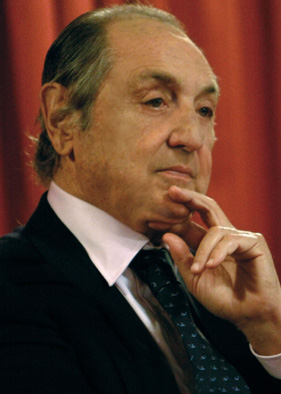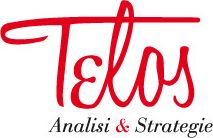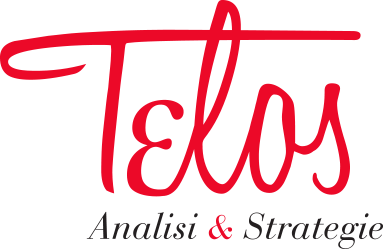July 2023, Year XV, no. 7
Emmanuele F.M. Emanuele
A Renaissance Man
“The expression I often use to talk about my activities in the years subsequent to my professional career, from the age of 60 on, is indeed that of giving back everything that, during the miracle of my life, I have received.”
Telos: “After receiving so much in my 50-year professional career, I knew it was time to give back.” What was the result of this sense of urgency?
Emmanuele Emanuele: I have always thought, even during my university and professional career and as the administrator of public and private companies, that my professional success was somewhat miraculous, because it allowed me, when I arrived from my natal Sicily in the sixties, to almost immediately enter the top national and international echelons. Therefore, the expression I often use to talk about my activities in the years subsequent to my professional career, from the age of 60 on, is indeed that of giving back everything that, during the miracle of my life, I have received. In order to do this, I identified the neediest sectors of society in the dramatic times we are currently experiencing: the healthcare sector, where there are pathologies that are often ignored and consequently lacking in care and requiring specialist scientific research; helping the less fortunate, which very often and increasingly translates into meeting people’s dietary needs, especially in the regions of southern Italy and the Mediterranean; education, a key element that will allow us to overcome barriers between social classes, ethnic and religious groups, as well as culture. I have oriented my life toward these goals, contributing decisively to protecting the economic assets of the old Italian savings bank Cassa di Risparmio and, even before that, of the very old loan institution Monte di Pietà, and through the Foundation – first, the Fondazione Cassa di Risparmio of Rome and then the Fondazione Roma tout court, which I established – ensure that the profits generated by the brilliant use of economic resources were channelled into the sectors mentioned above.
So, science and healthcare are central to your philanthropic life, as well as art and culture. Could you tell us about your most recent projects?
In the area of healthcare, 30 years ago I thought of creating a Hospice for terminally ill patients to provide free assistance to people in their last 30-50 days of life. However, my project was demonised, because at the time, palliative care had yet to become part of our national healthcare system and had negative connotations, which led to one constant in my experience: solitude.
For those pathologies where there is no cure, such as Lou Gehrig’s disease and Alzheimer’s, I created facilities to take in patients suffering from these diseases free of charge. I also provided support in ophthalmology by contributing very significantly for 30 years to the activities of the Bietti Foundation, which today is one of the top foundations worldwide in the treatment of glaucoma. Recently, I have contributed to cutting-edge healthcare research, such as, just to name a few: the CEMAD, a pioneering facility of Gemelli Hospital in Rome in the diagnosis and treatment of acute and chronic digestive tract pathologies, which has recently been recognised internationally; the MEBIC, an interuniversity consortium established through the collaboration between Tor Vergata University and the Telematic University San Raffaele in Rome with the aim of studying the shape of cells magnified millions of times to investigate the effects of pharmaceuticals, the interaction between molecules and the effect of rehabilitation at the molecular and cellular level; my collaboration with the Hospital Physical Therapists Institutes (IFO), to whom we donated a state-of-the-art confocal microscope to use in translational research and in precision medicine.
In terms of culture, I transformed the spaces of Palazzo Cipolla, once used for banking activities, into an exhibition space where since 1999 I have supported the hosting of 59 temporary exhibitions. At Palazzo Cipolla, I wanted to explore the art of faraway lands (like China, India, Japan, Russia, the USA) and the fruitful merging of art and new technologies (Quayola, Ipotesi Metaverso), in addition to another roughly 50 exhibitions in southern Italy and abroad. At the same time, over the years I have implemented the Permanent Collection of the Rome Foundation, housed within an ad hoc exhibition space at Palazzo Sciarra and including works of art from the 1400s to today, including an innovative contemporary section dedicated to street art. Regarding this, one of the projects most important to me is an open-air museum at Tor Marancia, in Lot 1 of this working-class neighbourhood in Rome. In 2015 I supported a project called “Big City Life”, involving 22 street artists from 10 different countries all over the world. They painted the facades of buildings as if they were enormous canvases, giving life to a truly unique brand of urban requalification that transformed this residential area into a colourful art district.
Right now, we are experiencing what, each time, appear to be epoch-making revolutions at a velocity never been seen before. In your cultured eyes, full of life lived intensely, what do you think are the real changes and what are just short-lived chimeras?
If there is one dominant feature of human history, it is that change is continuous and incessant; however recently this change has become faster, with increasingly significant consequences across the board. In fact, we are experiencing a digital revolution that is closely connected to technological progress and the rise of the internet and global connectivity, as well as the dizzying expansion of robotics and artificial intelligence. To use a synthetic but significant image, we are going from being an ‘analogue’ man to a ‘digital’ man, or the man who is experiencing this novel dimension, filled with potential but with just as many risks, with excitement but also unconsciously and with dangerous superficiality. Mobile phones, icons of today’s world, have become absolutely central to our lives and to our way of relating to the outside world by simplifying many activities and making numerous services accessible. We entrust all sorts of data to them, even data relating to our health. In the field of healthcare, for example, today there are physicians who dialogue with patients using WhatsApp or platforms that allow them to use virtual assistants. They perform surgical operations using remote-control robotic arms; AI algorithms can read and assess diagnostic results. New tech has now invaded every area of our daily life and obviously even impacts the work sphere, significantly contributing to either helping or replacing man in repetitive, strenuous activities, ones that require absolute precision, including intellectual activities. These brief remarks make it clear that this process is irreversible and unstoppable, which is indeed why it must be governed, not demonised or, even worse, ignored. Actually, our digital future could be envisioned as being at the service of man, as is already happening in the working sphere. As I have mentioned, it streamlines and speeds numerous tasks and processes, produces new professions when others disappear, facilitates scientific progress, especially in the medical field and in research, in environmental protection and alternative energies; and it opens us up and allows us to know spaces, cultures, faraway and diverse realities through immediate, global connectivity. However, this epoch-making revolution must be tempered by allowing more and more space for cultural creativity in all areas as a remedy against the power of the algorithm.
You are a university professor, a lawyer, an economist, an essayist and the administrator of various types of companies and entities. Yet you are also a poet and a lover of art and music. Many are the 'personae' you have been and are. In which of them do you find your deepest essence?
Helping others, because of the happiness it gives me, according to an old teaching adopted from my family. Helping ‘the last ones’, in the words of my father, a physician, aristocrat, man of action, fighter for liberty, who spent his whole life, after long days in his clinic, going around the poorest neighbourhoods in our city to help those in need.
And, as I have already said, culture, which I believe plays a key role in society. In my case, this manifests as poetry, as a passion for music, which led me to create the Rome Symphony Orchestra and the Piazza Vittorio Orchestra, and finally, in the visual arts, as I said before. I find my essence and a reason for living in these things in this last phase of my existence.
Marco Sonsini
Editorial
Thinking of a title that sums up the meaning behind our interview is no easy task. Sometimes it comes from a flash of insight, other times from long reflection and fine-tuning. In the case of our July guest for PRIMOPIANOSCALAc, Professor Emmanuele Emanuele, the title just came to us on its own. It was almost disarmingly simple. His interview, which you will devour, comes together like mosaic tesserae, creating the archetype of the Renaissance man: cultured, multifaceted, skilled in many fields and disciples, who considers man the centre of the world, who pursues the truth through the rules and laws that shape life in nature and in society. Although he still harbours a sense of the divine and of the importance of the religious dimension: Marsilio Ficino’s man as the copula mundi, the creature between God and nature who has been given the task of ennobling his existence through knowledge and work.
This isn’t just any old interview, a simple Q and A. It is an accurate, highly detailed account that unfurls slowly and easily through family memories, his commitment to others, science, care, health and art. The story of a journey, an adventure, a path, a sort of Ariadne’s thread that leads us through his rich, inner labyrinth. A comprehensive account of a life that weaves together business, academia, science, poetry and music with grace, without ever being overbearing. The Professor is no spring chicken, so you would expect just to read his memories from his more or less distant past. But you’re dead wrong. One of the central features of his story is change, which he defines as the “dominant feature of human history”, even though he acknowledges that in recent years, the pace of change has almost become dizzying.
He speaks to us, fascinated, about the terrible, wonderful challenge of Artificial Intelligence, the current hot topic. What, the answer to governing AI is right before our eyes? Yes, “by allowing more and more space for cultural creativity in all areas as a remedy against the power of the algorithm.” Now I’ll let his words draw you into his dream, which has become many, many realities.
The 2023 covers of PRIMOPIANOSCALAc were designed to create, with the faces of the contributors, something similar to museum merchandise. Every month we personalise an item with the black and white face of our guest. This way, a t-shirt, magnet or shopper becomes a memory, an experience, a symbol. Our guests become icons, just like museum pieces such as Da Vinci’s Vitruvian Man, Van Gogh’s sunflowers, Michelangelo’s The Creation of Adam in the Sistine Chapel… For the Professor, we have chosen a spiral notebook, perfect for taking work notes, as a personal diary or travelogue. Then, if you want, you can tear out a page and keep it among your dearest memories.
With this July issue, all of us at Telos wish you a fantastic summer, with a dip in the blue sea... and a nice slice of fresh watermelon!
Mariella Palazzolo

Emmanuele Francesco Maria Emanuele is the President of the Fondazione Terzo Pilastro-Internazionale and the Honorary President of the Fondazione Roma. After earning a law degree from the University of Palermo, he continued his postgraduate study at the Higher Institute for Business Management at Harvard University. His academic career began in the seventies. He is a professor of Tax, Business, Financial and Financial Science Law and other subjects at numerous universities, from the Federico II University of Naples to the Faculty of Economics of the University of Salerno, from LUISS to the Link Campus University of Malta. He has received numerous honorary degrees, such as a fine arts PhD from St. John’s University in Rome, a degree in Canon Law from the Pontifical Lateran University in Rome, a Humane Letters degree from the American University in Rome and a degree in Medicine and Surgery from the Catholic University of the Sacred Heart. Since 1990 he has been a lawyer at the Italian High Court of Cassation, since 1996 he has been a member of the Registry of Experts at Italy's Interbank Deposit Protection Fund. Since 2020 he has been on the Honorary Committee of the European University of Rome, and in the past, he covered various different roles in the university boards.
Over the course of his career, he has served as President, a board member and a business and public industries consultant in the public and private sector at the international level, for example, as vice President of the Cassa di Risparmio in Rome (1982-1995), President of Leasing Roma (1985-2000), President of ISVAP- Institute to Oversee Private Insurance and Collective Interest (1994-1996), just to name a few.
A true philanthropist, over the years he has also worked in healthcare, promoting support for hospitals and care facilities. In 1999, before the introduction of palliative care, designed and backed the creation of the Hospice in Via Poerio in Rome, a facility for the terminally ill. In 2017 he promoted the creation in Rome of a residential village for people with Alzheimer’s, which was named Villaggio Emmanuele F.M. Emanuele in his honour. In addition, he has held numerous positions in Institutes engaged in scientific research such as the IRCCS-Fondazione 'G. B. Bietti', for Study and Research in Ophthalmology where he was the Honorary President (2016-2023).
He is passionate about art and culture and is a patron of the arts. He was the President of the Italian section of the Mediterranean Council of Culture under the patronage of UNESCO. He was on the board of the Venice Biennale Foundation; honorary President of the Rome symphony orchestra. He is currently Honorary President of the 'Centro Europeo di Studi Normanni' in Ariano Irpino.
He is the author of numerous publications on Law and Economy (including “Il Terzo Pilastro. Il non-profit motore del nuovo Welfare”, del 2008) as well as literary publications. He has written books of poetry: “Una Lungo Cammmino” (2008), winner of the 2009 Margutta Prize; “Le Molte Terre” (2009), winner of the 2010 Mondello Prize - Special Jury President's Award and Laurentum Prize in 2010; “La Goccia e lo Stelo” (2013); “Pietre e Vento” (2016); “Vivere nel sole” (2021); “Versi in cammino”. (2023). In the art field, he wrote the book “Vivere nell’Arte” (2023).
He loves sports and has practiced fencing, rugby, golf, rowing, swimming and much more.
He was born in Palermo and lives in Rome.
Marco Sonsini







SocialTelos